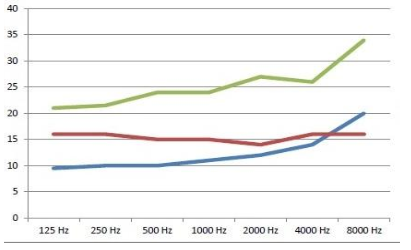This is part 3 of a series on how to choose the right hearing protection as part of the Personal Protective Equipment (PPE) and what things to consider. In this series we will help you to make informed choices and save money while putting safety of hearing at the forefront.
In this part we will briefly touch on specific attenuation, Compliance and Ability to Communicate.
Summary Part 1
In Part 1 we discussed safe noise levels (in dB) and safe hearing times (in hours and
minutes). We spoke about damaging noise levels if those noise levels are above
85dB. The twist came with the pitch (the frequency of the sound/noise). Different
things can produce the same noise level but at different frequencies. It is important
to understand that sound levels above 85dB need to be reduced at their own specific
pitch (range). You buy your earplugs (custom moulds) or earmuffs not only with the
sound level in mind but also the range of the sound (low, mid or high frequencies).
Hearing Protectors and Classification
In Australia and New Zealand hearing protection, earmuffs or in-ear protection
(moulded earplugs) are rated against the AS/NZS1270 standards. If certification is
provided it comes in a Class system, class 1 to 5. Five being the highest damping
classification but not necessarily the best for your situation. The AS/NZS also
mentions the SLC80 level, an amount of dB damping. In Europe it is called the SNR
rating and sees to the amount of sound reduction from 10 to 39 and over in dB.
It is important to note that the numbers coming out of these tests are averages. A
Class 5 means merely that the average sound reduction across all frequencies is
26dB or more. It could be 20dB in the lower ranges, 25 in the mid-ranges and 35 in
the high ranges. The same goes for any SNR rating.
Every protector, earplug or earmuff, has its own acoustic specification and
attenuation (sound reduction or damping) characteristics. Some protectors, and this
is rare, have a “flat’ attenuation (reduction) curve, meaning the same level of
attenuation across the frequency levels.

Most (custom fitted or moulded) earplugs and earmuffs have different sound reduction levels at different frequency levels. It is therefore important to note that you need to match the sound spectrum (sound level and frequencies) in your environment with the right hearing protector.
Again, there is no one size fits all in hearing protection. This is where choosing the right hearing protector becomes interesting.
Prerequisites
With the right sound “type” in the back of our heads, there are two prerequisites we need to acknowledge before choosing the right hearing protector, whether it be (custom fitted) earplugs or earmuffs.
1. Wearing hearing protectors as much as possible.
We need to make sure that everyone continuously wears the protectors during their shift. Taking them off (muffs) or out (earplugs) at any stage on the work floor exposes the wearer to noise created by others or other machinery. Communication is normally the reason people take their protectors off or out.
2. Communication must be possible
People need to be able to communicate as much and as natural as possible, on the phone, on the radio, hear warnings, have discussions and so on. In order to be able to communicate, we need to attenuate (reduce) the sound level in the speech ranges preferably only to, or just below, 85dB, the safe level. This also increases compliance with wearing protectors.
There is no point in choosing a hearing protector, if these are not accepted or considered. Hearing protection works only when it is used and used regularly.
Conclusion – part 3
Whichever industry you are in, hearing protection is very specific. Not only the sound spectrum (frequency and sound level) are important but needs to be matched with the right hearing protector and their specific damping characteristics (attenuation levels). A classification is not enough to decide on for a hearing protector. The actual damping curve within a classification is possibly even more important.
We want people to be able to communicate, do their work and preserve hearing at the same time.
Do it right and you save a lot of time, effort and money!
Next in this series: Comparison Earmuffs vs Custom Ear Plugs
If you would like more information in the meantime, please contact our offices in Australia or New Zealand at any stage.

